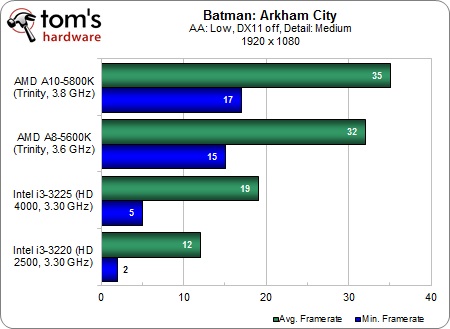Gaming At 1920x1080: AMD's Trinity Takes On Intel HD Graphics
Think you're pretty snazzy because your integrated graphics core plays mainstream games at 1280x720? We're on to bigger and better things, like modern titles at 1920x1080. Can AMD's Trinity architecture push high-enough frame rates to make this possible?
Benchmark Results: Batman: Arkham City
From dirt track to dirty skyscrapers, let’s shift to the latest Batman installment, Arkham City.
Both AMD APUs deliver a playable experience at the lowest settings, albeit with minimums that dip below where we'd like to see them. Intel takes a Batarang in the back here.
For all of this heavy load, what do you get in return (if you can play at all)?
There are definite texture quality advantages in moving from Low to Medium settings. With DX 11 engaged, we see the High settings do a better job with light dispersion, which is particularly handy in a dark game like Batman. The shadows that appear in Medium offer an obvious upgrade to our Low settings. So, clearly, there are good reasons to want more horsepower. The problem is that you’re not going to get it from today’s integrated processors.
It’s arguable whether AMD gets a pass at Medium settings with minimum frame rates dropping into the teens. At High, everyone gets obliterated. But, given that we see the jump from Low to Medium being most significant here, we find this a promising case for AMD and another instance in which we’d lean on a little overclocking to help boost those minimum rates without sacrificing our other HTPC priorities.
Get Tom's Hardware's best news and in-depth reviews, straight to your inbox.
Current page: Benchmark Results: Batman: Arkham City
Prev Page Benchmark Results: DiRT Showdown Next Page Benchmark Results: World Of Warcraft-
azathoth Seems like a perfect combination for a Casual PC gamer, I'm just curious as to the price of the Trinity APU's.Reply -
luciferano They both have graphics that have HD in their name, but AMD's HD graphics are more *HD*, lol.Reply -
Nintendo Maniac 64 Err... did we really need both the A10-5800k and the A8-5600k? Seeing how both are already 100w unlocked CPUs, surely something like an A10-5800k vs a 65w A10-5700 would have been more interesting for an HTPC environment...Reply -
mayankleoboy1 Consoles set the bar for game developers. These iGPU's are comparable to the consoles and thats why games will run smooth here.Reply
With next gen consoles coming out next year, game devs will target them. Hence the minimum standard for games will rise, making the next gen games much slower on the iGPU's. So both AMD and Intel will have to increase performance much more in the next 1-2 years.
tl;dr : next gen games will run poorly on these igpu's as next gen consoles will set the minimum performance standard. -
mousseng Reply
Keep in mind, though, that that's exactly what's going to allow AMD and Intel to advance their hardware faster than games will, as they were discussing in the article (first page of the interview). Look how far Fusion and HD Graphics have come over the past 3 years, and look how long the previous console generation lasted - if that trend is anything to go by, I'm sure integrated graphics could easily become a viable budget gaming option in the next few years.9537609 said:tl;dr : next gen games will run poorly on these igpu's as next gen consoles will set the minimum performance standard. -
falchard Since when as AMD or nVidia actually taken on Intel graphics? Thats a bit insulting considering the disproportionate results time and time again.Reply -
luciferano mayankleoboy1Consoles set the bar for game developers. These iGPU's are comparable to the consoles and thats why games will run smooth here.With next gen consoles coming out next year, game devs will target them. Hence the minimum standard for games will rise, making the next gen games much slower on the iGPU's. So both AMD and Intel will have to increase performance much more in the next 1-2 years.tl;dr : next gen games will run poorly on these igpu's as next gen consoles will set the minimum performance standard.Reply
Actually, the A10 and A8 have somewhat superior graphics compared to current consoles. Current consoles can't even play in 720p as well as these AMD IGPs played 1080p despite being a more optimized platform, so that this is true is kinda obvious IMO. Also, new games would simply mean dropping resolution for these APUs. They wouldn't be unable to play new games, just probably at 1080p and 16xx by 900/10xx resolutions too.
Intel probably isn't very motivated by gaming performance for their IGPs and they're supposedly making roughly 100% performance gains per generation with their top-end IGPs anyway, so they're working on growing IGP performance. AMD also gets to use GCN in their next APU and I don't think that I need to explain the implications there, especially if they go the extra mile with using their high-density library tech too.





